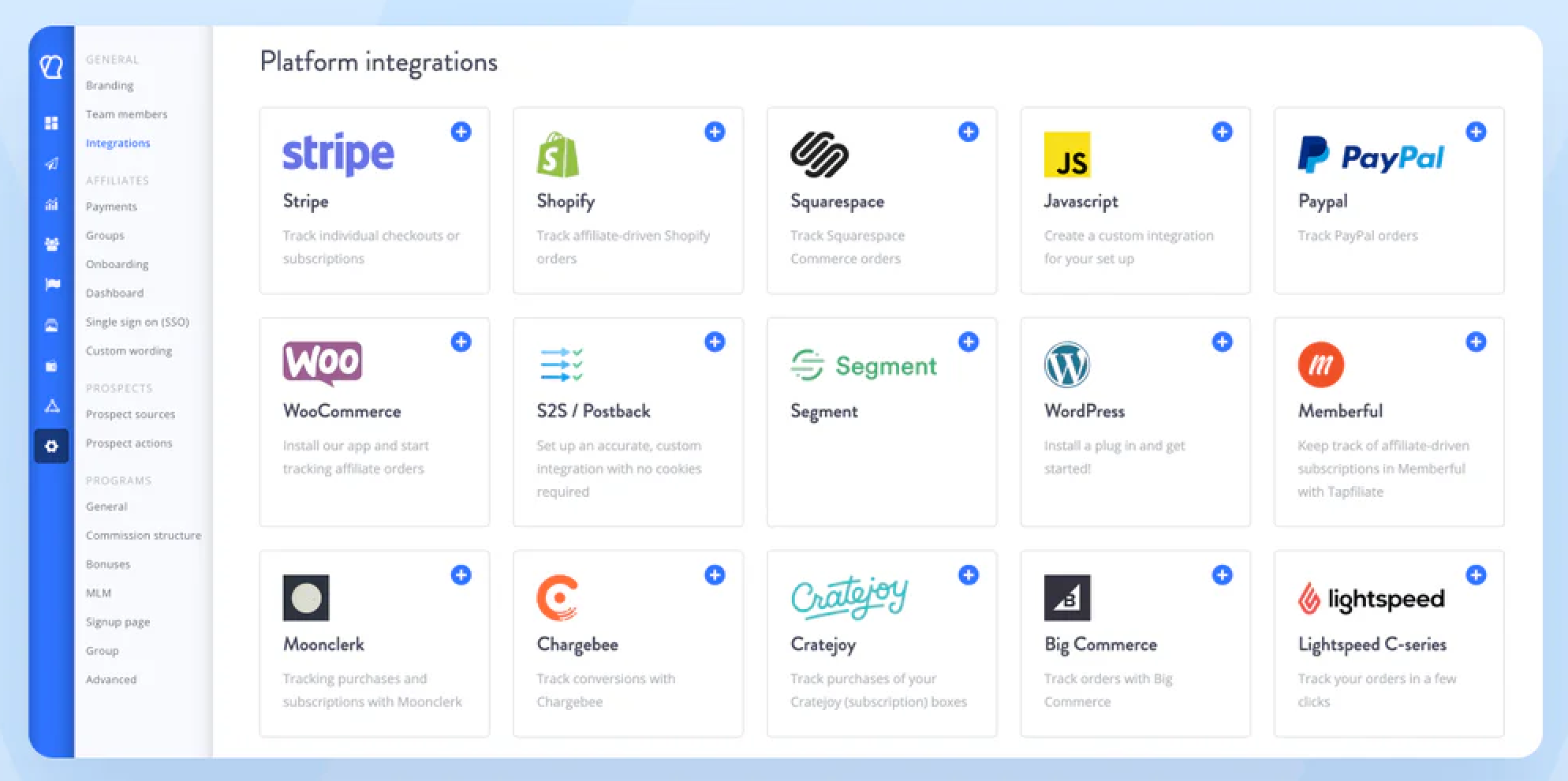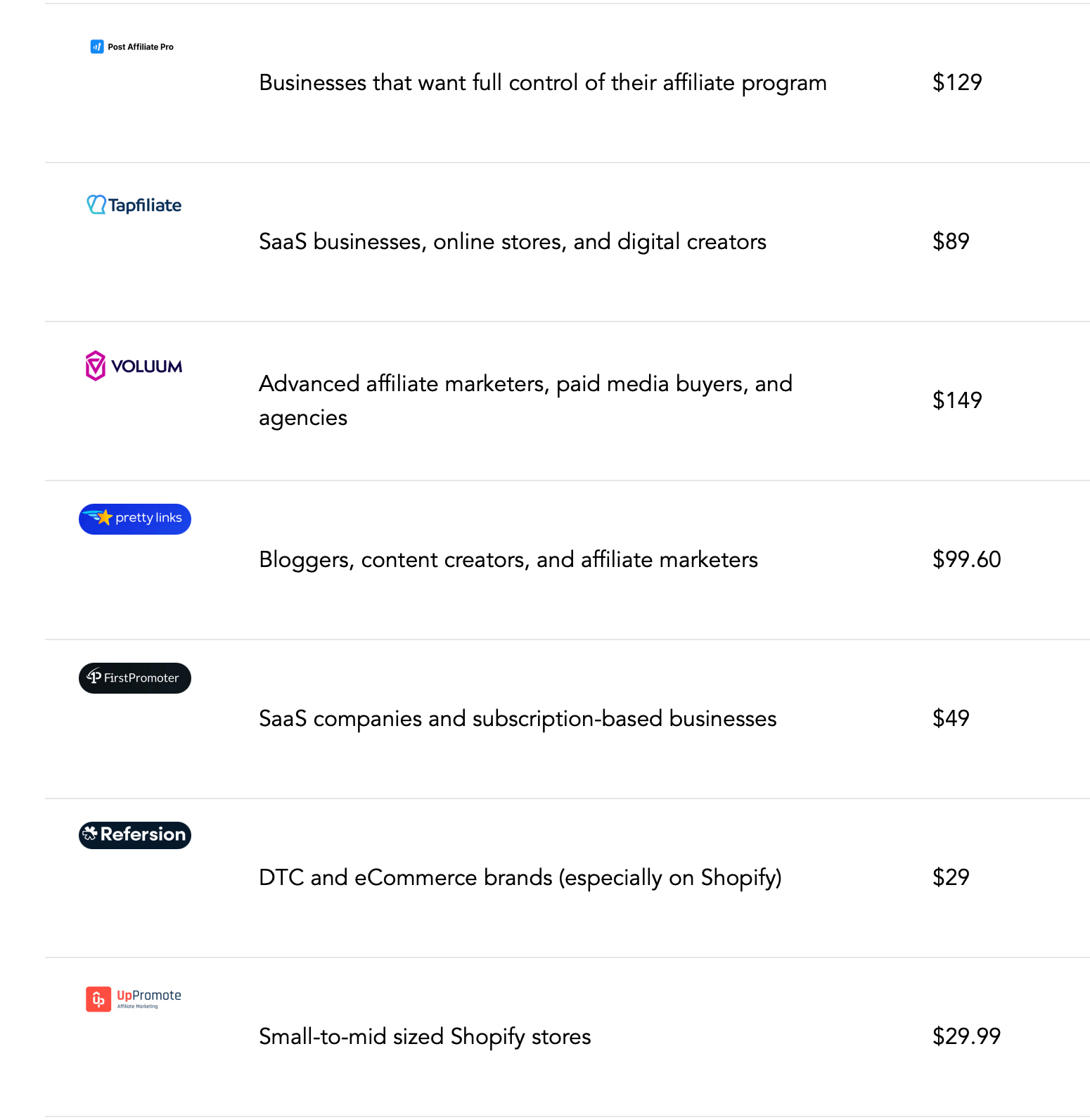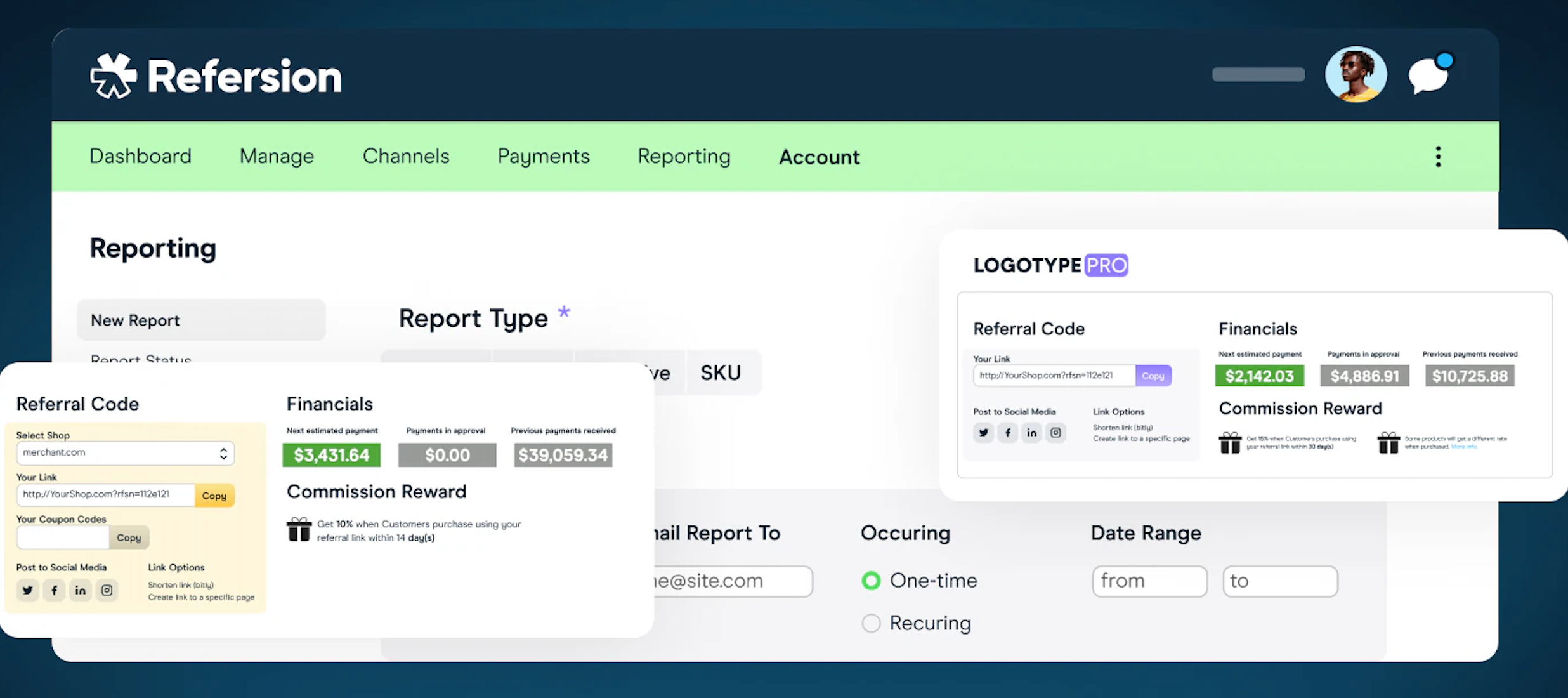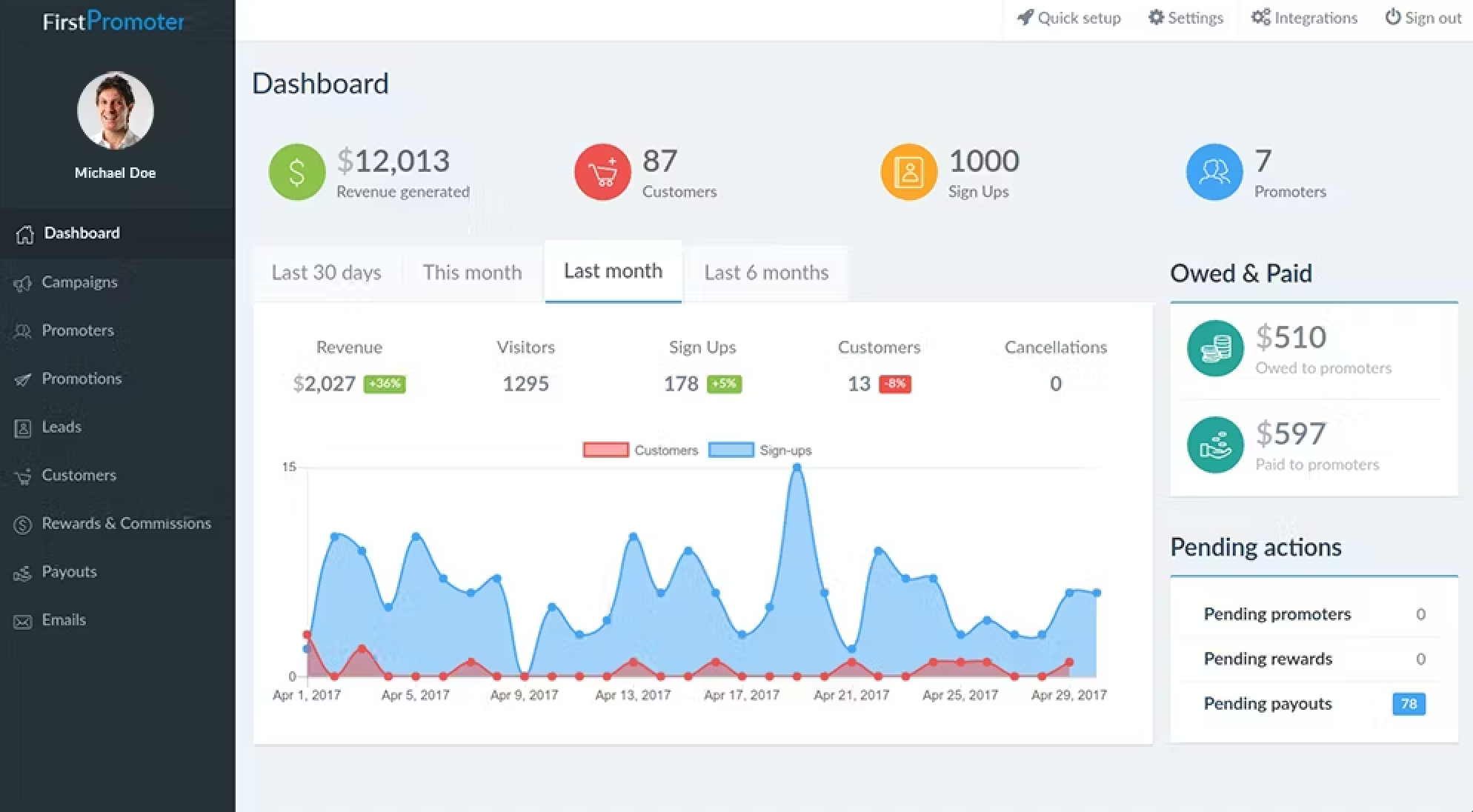I. Intro
Do you think it is hard to find an affiliate marketing tool? Well, without one, you’re stuck juggling spreadsheets, manually sending links, and answering the same tracking questions over and over. So, you will have to find one.
Of course, not all platforms are built the same. Some are great for Shopify brands, others are built for SaaS companies. Some automate everything, others give you more control (and more complexity). Choosing the wrong one can slow you down, or worse, turn off your affiliates before they even start.
In this guide, you will find no hype, no vague “top 10” lists. Just clear, honest comparisons of affiliate platforms based on how they actually work in the real world.
We’ll help you answer questions like:
- Which platform fits the way my business sells?
- What features will save me time as I scale?
- How do tools like Refersion, FirstPromoter, or Tapfiliate really compare?
- What’s overkill, and what’s essential?
If you’re building (or rebuilding) your affiliate program and want to pick the right software from the start, this guide is for you.
II. What to look for in an affiliate marketing platform
There are a ton of affiliate platforms out there, each promising to make your life easier. But before you start comparing logos and pricing pages, take a step back and ask the real question:
What features will actually save you time or help you grow your program?
Let’s walk through the key things to pay attention to:
1. Ease of Use
How easy is it for both you and your affiliates to use the platform?
Can you onboard someone in minutes, or do they need a full tutorial just to find their link?
Look for a clean dashboard, simple setup, and a process that won’t create headaches as you scale.
2. Tracking Accuracy
If the platform doesn’t track properly, nothing else matters.
You want accurate link attribution, solid cookie tracking (30–90 days is common), and confidence that affiliates get credit when they should.
Bonus: Some tools even offer first-click vs. last-click attribution options.
3. Commission Flexibility
Not every brand runs on the same model.
Can the platform support different setups like flat rates and percentage-based payouts?
Can you offer recurring commissions for subscriptions? Tiered rewards for top performers? The more flexible the system, the easier it is to grow.
4. Integrations

Does the tool plug into the rest of your stack?
If you’re on Shopify or WooCommerce, you’ll want a native integration.
Running a SaaS? Make sure it connects to Stripe or your billing system.
Good integrations = less manual work and more automation.
5. Reporting & Analytics
You need to know what’s working and what’s not.
Can you track which affiliates are driving clicks or sales?
Do you get campaign-level data, or just one big summary?
Look for reports that actually help you make decisions, not just vanity numbers.
6. Payout Automation
This is a big one.
Does the platform handle affiliate payouts for you, or will you be sending PayPal transfers one-by-one every month?
Look for tools that support auto-pay via PayPal, bank transfer, or Stripe.
Bonus points if you can set thresholds, payout windows, and hold periods for refunds.
7. Support & Documentation
Things will break. People will have questions.
Do they have a live chat? Email support? An account manager for higher-tier plans?
Good documentation (videos, how-tos, FAQs) will save your team a lot of time down the line.
8. Pricing

Last but definitely not least.
Is pricing transparent? Do they charge per click, per affiliate, or a flat fee?
Some tools scale well as you grow. Others start cheap, then nickel-and-dime you as you add features.
Make sure to compare real costs, not just the number on the homepage.
Quick tip: Before committing to a platform, test the affiliate experience yourself. Sign up as if you were a creator. If it feels clunky or confusing, your affiliates will think so too, and that can kill momentum fast.
III. Affiliate marketing platform overviews and use cases

1. Refersion
Best for: Shopify brands, early-stage eCommerce startups
Ideal for: DTC brands that want a plug-and-play experience without a big learning curve
Refersion is one of the most popular affiliate tools for Shopify users, and for good reason. It’s built specifically with eCommerce in mind, so the setup process is fast, and the integration feels native if you’re using Shopify.
You can create affiliate links, track commissions, and manage payouts all from a single dashboard. There’s even a marketplace where creators can apply to promote your brand, which is helpful if you’re just starting and don’t have a network yet.
Strengths:
- Seamless Shopify integration (literally a few clicks)
- Fast onboarding for affiliates
- Built-in affiliate discovery marketplace
- Easy to create promo codes and track performance by creator
Limitations:
- Not great for non-eCommerce businesses (like SaaS or services)
- Limited flexibility if you want recurring commissions or custom logic
- Reporting is more “basic summary” than deep insights
Renue by Science case study
When Renue by Science, a longevity-focused supplement brand, wanted to expand their reach without blowing their ad budget, they turned to affiliate marketing, and chose Refersion to power it.
They started small: a signup page, a few loyal customers, and some tracking tools. But with Refersion’s easy setup and strong support, the program quickly scaled.
A few years later? Their affiliate program has generated over $13.7M in revenue, with a 656% increase since year one. Much of that growth came from happy customers and influencers who already believed in the product, and now had a reason to share it.
Their take? Simple platform, good support, big results.
2. FirstPromoter

Best for: SaaS companies with recurring revenue
Ideal for: Any subscription-based product, think online course platforms, CRMs, or membership tools
FirstPromoter was built with SaaS in mind. If your business runs on subscriptions and uses Stripe for billing, this platform fits like a glove. It automatically tracks recurring payments, handles lifetime or multi-month commissions, and gives affiliates a clean dashboard to monitor earnings.
The Stripe integration is a standout, it syncs data in real-time, so you’re not chasing numbers manually. You can offer one-time or recurring commissions, set up custom rewards, and even tiered bonuses if your affiliates perform well.
Strengths:
- Native Stripe integration (zero manual setup for billing)
- Recurring and lifetime commissions
- White-label affiliate dashboard
- Helpful support and active development team
Limitations:
- Mostly optimized for Stripe users, other payment platforms may require workarounds
- Less ideal for one-time purchases or physical products
- Limited built-in discovery features (you have to bring your own affiliates)
Submagic case study
Submagic, an AI video captioning tool, launched fast and lean. Within just 60 days of going live, they’d already added 500 affiliates and made $10,000+ in revenue—all without running paid ads.
Their secret? A clean offer, a strong brand, and FirstPromoter powering the backend.
Because they’re a subscription SaaS product, recurring commissions were non-negotiable. FirstPromoter synced seamlessly with Stripe, let them reward creators long-term, and gave affiliates real-time dashboards so everyone stayed motivated.
For Submagic, the affiliate program wasn’t just a side channel, it was the growth engine.
3. Tapfiliate
Best for: Brands needing flexibility and integrations
Ideal for: Businesses that want flexibility without hiring a developer, whether you’re in eComm, SaaS, or something in between
Tapfiliate is like the Swiss army knife of affiliate platforms. It doesn’t lock you into one ecosystem, it works with Shopify, WooCommerce, WordPress, Squarespace, and plenty of SaaS setups. You can even hook it into Zapier to automate just about anything.
It’s also one of the more globally friendly options: multi-language support, customizable dashboards, and affiliate links that work across borders make it a solid pick for international brands.
Strengths:
- Platform-agnostic (works for both SaaS and eCommerce)
- Zapier integration for custom automations
- White-labeled dashboards and links
- Easy to set up and use, even for non-technical teams
Limitations:
- Analytics and reporting are more basic data-heavy teams might want deeper insights
- No built-in affiliate discovery features
- Some advanced setups (like tiered programs) may require workarounds
Hyperzod case study
Hyperzod, a white-label delivery management software, needed a way to scale without pouring money into ads or cold outreach. They turned to affiliate marketing, and chose Tapfiliate to manage it.
Why? Flexibility and simplicity. With Tapfiliate, they launched a referral system that fit their B2B model, tracked everything in one dashboard, and let partners start promoting quickly without technical headaches.
Since launching, Hyperzod’s affiliate program has helped them reach customers across multiple countries and build long-term referral relationships, all while keeping acquisition costs low.
For a lean, growing B2B brand, Tapfiliate gave them the structure they needed without the complexity.
IV. Affiliate Platform Comparison Table
| Feature / Platform | Refersion | FirstPromoter | Tapfiliate |
| Best For | Shopify, eComm startups | SaaS with subscriptions | Flexible use across SaaS & eComm |
| Ideal Use Case | Plug-and-play DTC setup | Subscription products, Stripe billing | Brands with custom stacks or multiple store types |
| Key Integrations | Shopify, WooCommerce | Stripe, SaaS platforms | Shopify, WooCommerce, WordPress, Zapier, custom platforms |
| Commission Types | % of sale, flat, promo codes | Recurring, lifetime, tiered | Flat, %, recurring, custom via Zapier |
| Onboarding | Easy for beginners, affiliate discovery marketplace | Manual invite process, no discovery marketplace | Manual invite, easy setup with flexibility |
| Tracking Accuracy | Good for basic sales tracking | Real-time Stripe sync, recurring tracking | Reliable with Zapier and multiple setup options |
| Reporting | Basic summary-level reports | More advanced, supports deep analysis | Limited, may need exports or integrations for deeper insights |
| Payout Automation | Yes (limited customization) | Yes (highly customizable) | Yes, supports auto payouts |
| Customization | Limited (mostly template-based) | High (especially for SaaS logic) | Moderate to High (Zapier adds flexibility) |
| Global Support | Mostly US-based | Stripe-dependent | Multi-language, international support |
| Case Study | Renue by Science – 656% growth in affiliate revenue | Submagic – 500+ affiliates and $10K+ in 60 days | Hyperzod – used for global B2B growth |
V. How to choose the right affiliate marketing platform
There’s no “best” affiliate platform, only the one that fits your business.
To figure out which tool will actually work for you (and not just look good on a landing page), here are five simple filters to help you decide:
1. What’s your business model?
- eCommerce brand on Shopify? Go for something that plugs in smoothly, like Refersion.
- SaaS with recurring payments? FirstPromoter is built for Stripe and long-term commission tracking.
- Selling services or content? Flexibility is key. Tapfiliate or Post Affiliate Pro can be better fits.
Different tools are designed for different flows. Make sure yours is supported out of the box, or close to it.
2. How big is your team?
- Solo founder or small team? You want ease of use, fast setup, and simple automation. Pick a tool with good documentation and support (think: Tapfiliate, Refersion).
- Agency or dev team helping out? You can afford more complexity if it gets you the customization you need, Post Affiliate Pro might be worth it.
If you’re managing everything yourself, don’t choose a platform that needs a full-time manager.
3. What’s your budget and timeline?
Some tools charge monthly. Others take a cut. And a few do both.
- Bootstrapping? Start lean. Tapfiliate has affordable entry plans.
- Growing fast? Consider tools that scale with usage without charging per affiliate (like FirstPromoter).
- Launching now? Look for quick setup and helpful onboarding support. Tools like Refersion can be up and running in an afternoon.
Think about both short-term needs and long-term sustainability.
4. What tools are you already using?
Your tech stack matters. If your current systems don’t integrate, you’ll waste time fixing things that should just work.
- Running on Shopify? Choose a native integration like Refersion.
- Using Stripe? FirstPromoter is your best friend.
- Relying on Zapier for automations? Tapfiliate makes that connection easy.
Check integrations before you sign up.
5. What’s the goal of your affiliate program?
Be honest: are you looking for…
- Sales? You want strong conversion tracking and simple commission setup.
- Brand awareness or traffic? Look for tools that allow flexible commission types, like pay-per-click or influencer tracking.
- Long-term partners? Choose platforms with recurring commissions, affiliate dashboards, and strong reporting.
Your goal should shape the tool, not the other way around.
VI. Summary & recommendations
Choosing the right affiliate platform isn’t about picking the most expensive or most feature-packed option, it’s about picking the one that fits you.
Let’s quickly recap:
- Refersion is great if you’re running a Shopify store and want a smooth, fast setup.
- FirstPromoter is ideal for SaaS businesses with subscriptions and Stripe integration.
- Tapfiliate gives you flexibility if you’re juggling multiple platforms or want something lightweight.
- Post Affiliate Pro is powerful but best for larger teams with technical resources and custom needs.
Here’s how to move forward:
- Start by clarifying your affiliate goals: Are you aiming for more sales, leads, or traffic?
- Match that goal with your business model, team size, and existing tools.
- Choose a platform that supports your growth, not one that slows it down with complexity or features you don’t need.
If you’re not sure yet, most of these platforms offer free trials or demos. Test them out. Invite a few affiliates. See what feels right.
Pro tip: Don’t overthink it. Start simple, get your program live, and iterate. The best affiliate programs grow over time, not overnight.
Here’s the bottom line:
- Start with your goals.
- Choose based on how your business actually works.
- Don’t over-engineer.
- Keep it simple and scalable.
Test before you commit. Launch small. Improve as you go. The best affiliate programs evolve with your brand, not just because of the platform you choose, but because you build it with clarity and consistency.
Table of content
Looking for influencers?

About Stefan A.
Stefan is a Growth Marketer turned founder with a background in customer acquisition, Influencer Marketing, and early-stage startups. At Social Cat, Stefan drives day-to-day operations and growth, helping small brands connect with the right influencers to scale their reach and impact.









